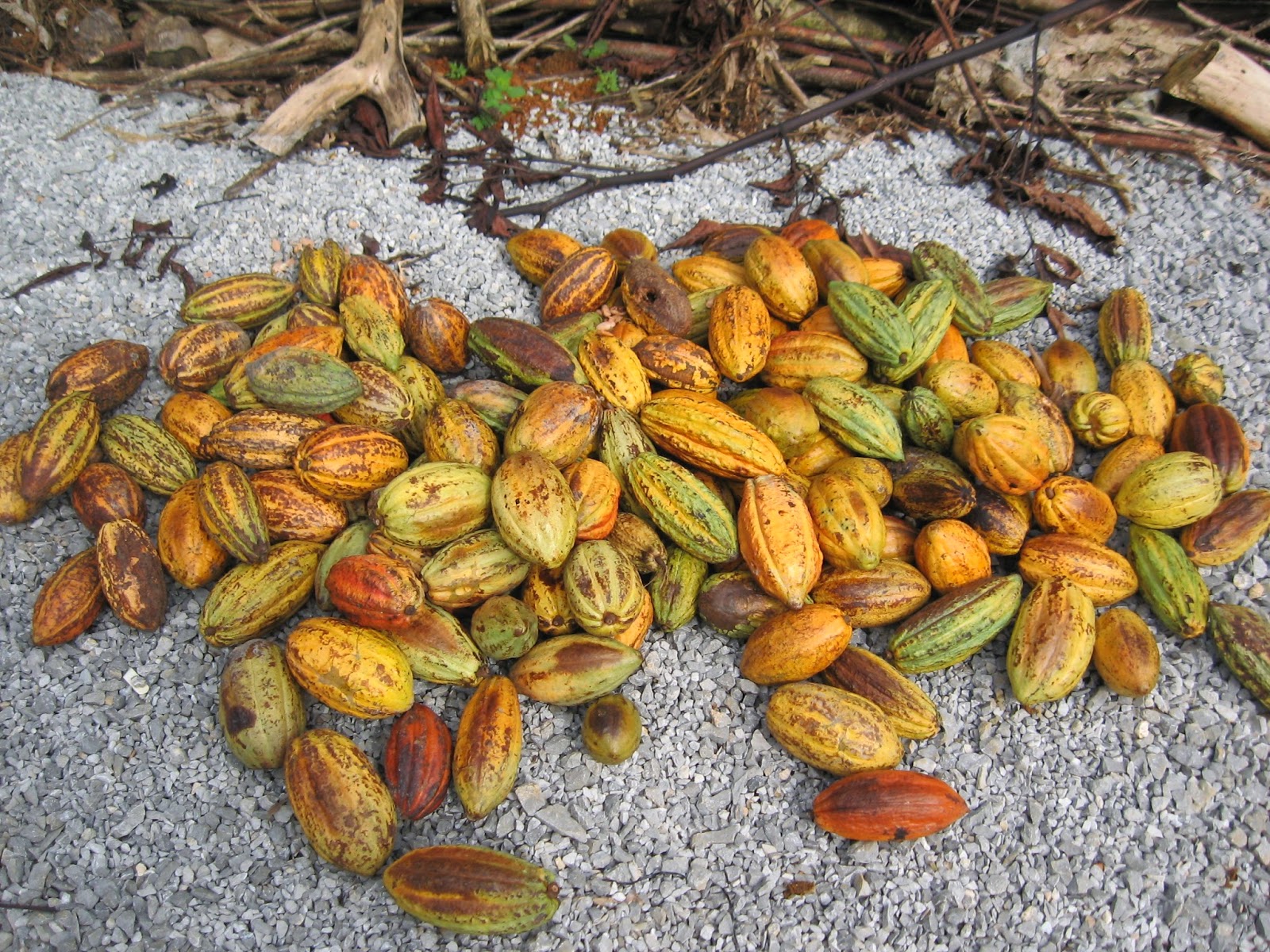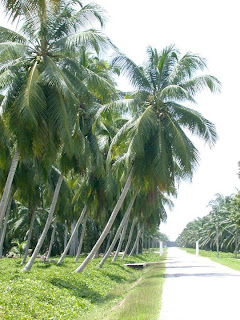Passionate about Cacao
Passionate about Cacao
Once the cocoa beans have been properly fermented, they are then dried under the fierce tropical sun. The beans are spread out thinly onto a cement pavement or wooden slates, and dried to an internal moisture of less than 7%. This may take 5-6 days, depending on the relative humidity and sunlight when the drying process is being done.
 An important note that should be made here is that unlike many other commodity crops, cacao is considered one of the most sustainable crop species to cultivate. This is because cacao trees are naturally understorey forest trees that require shading. Hence agroforestry is practiced, which involves maintaining a forest balance within a cacao farm. Interestingly enough, wildlife thrives in a agroforestry managed cacao farm, which in turn protects the local wildlife biodiversity. This is especially useful, since 75% of cacao farms are located on some of the most biologically diverse areas on the planet!
An important note that should be made here is that unlike many other commodity crops, cacao is considered one of the most sustainable crop species to cultivate. This is because cacao trees are naturally understorey forest trees that require shading. Hence agroforestry is practiced, which involves maintaining a forest balance within a cacao farm. Interestingly enough, wildlife thrives in a agroforestry managed cacao farm, which in turn protects the local wildlife biodiversity. This is especially useful, since 75% of cacao farms are located on some of the most biologically diverse areas on the planet!
Well that's it for now about cacao... Let me share with you some of my favorite cacao pictures:

When we last met, I had indicated that the two crops I'm truly
passionate about were cacao and coconuts. Now, I've posted quite a bit
about coconuts, so I figured it is time for cacao to take center stage.
Here it goes...
Cacao is definitely one of the more interesting agriculture crops I've had the privilege of working with. For one, this small evergreen tree native to the deep tropical regions of Central and South America produces cacao pods, which contain the cocoa beans, which are in turn used to make chocolates.
Oh yea... I bet I've caught the attention of you chocoholics!
But what really attracts me to cacao is less about the chocolate, but more because of the sheer genetic diversity displayed among cacao trees. Call it a plant breeder's vice, but we sure do love diversity. And in cacao trees, this type of genetic variation has resulted in some of the most colorful and vibrant display found among cultivated crop species.
Maybe it is all the volatile mood-altering compounds permeating through the air, but there's just something about seeing a good harvest of cacao pods that gets me really excited. Though it is possible that with cacao being such a difficult and finicky crop to cultivate, the thrill of seeing one's hard work pay off at the end of each harvest season just puts me in a good mood.
And did you that out of the 40,000 flowers
each year, only about 40-50 will finally make it as cacao
pods? Talk about disproportionate returns!
But seriously, cultivating cacao
isn't for the faint of heart. Not only is the cacao tree sensitive to
its macro climate (it can only be cultivated in the tropics, or at least
a well-designed greenhouse), it is also prone to a huge list of
diseases.
In addition, humans aren't the only creatures that are in love with cacao... most mammals seem to adore it, including wild elephants who would regularly raid cacao farms. Apparently, they get drunk when the sweet pulp surrounding each cocoa bean ferments in their bellies and turn into alcohol.
Even after harvesting the pods, getting
the cocoa beans out isn't easy. Depending on the variety grown, it will
either be necessary to break the pods open with a small wooden mallet,
or with a machete.
The tool that would be used will depend on how thick
the cacao pod husk is... some can be mere millimeters in thickness,
while others can get up to an inch or more.
Whichever the case it may
be, after smacking open 1,000 or more pods in a few hours, your hands will
definitely be aching. Do note that an acre of cacao trees can produce around 16,000 cacao pods (!!!)...
Once each pod has been opened, the 50-60 cocoa beans
contained within will then have to be scooped out. Each cocoa bean will
be encased in a sticky, slimy pulp. Which isn't a bad thing, since the
pulp is not only edible, but tastes surprisingly sweet and tangy,
somewhere between lychees and soursop.
The next step isn't as pleasant though... especially if you are the squirmish sort. Because now, the cocoa beans will need to be fermented.
Basically, the collected cocoa beans will need to be placed in a shallow wooden box at least 30cm deep, with slits at the base to allow any liquids (called cocoa "sweatings") to escape.
The sides of the box are lined with banana leaves, and once filled with cocoa beans, are covered with a few layers of banana leaves or jute sack to help insulate the box. The beans are then left to ferment over the next 5-6 days, making sure to churn over the beans every day.
Fermenting the cocoa beans is necessary, because the characteristic chocolate flavors we know so well is developed during this process. Many biochemical process are going on while the cocoa beans ferment, the most important of which is called the Maillard Reaction, which converts crude polyphenols, amino acids, proteins and sugars into a whole range of complex compounds. This reaction not only results in the unique aroma of chocolate, but also turns the purple-colored cocoa beans brown.
Once the cocoa beans have been properly fermented, they are then dried under the fierce tropical sun. The beans are spread out thinly onto a cement pavement or wooden slates, and dried to an internal moisture of less than 7%. This may take 5-6 days, depending on the relative humidity and sunlight when the drying process is being done.
As cacao are grown primarily along the tropical rainforest regions of the world, there is always a risk of sudden rainfall. So to protect the drying beans, some means of roofing will be needed.
 An important note that should be made here is that unlike many other commodity crops, cacao is considered one of the most sustainable crop species to cultivate. This is because cacao trees are naturally understorey forest trees that require shading. Hence agroforestry is practiced, which involves maintaining a forest balance within a cacao farm. Interestingly enough, wildlife thrives in a agroforestry managed cacao farm, which in turn protects the local wildlife biodiversity. This is especially useful, since 75% of cacao farms are located on some of the most biologically diverse areas on the planet!
An important note that should be made here is that unlike many other commodity crops, cacao is considered one of the most sustainable crop species to cultivate. This is because cacao trees are naturally understorey forest trees that require shading. Hence agroforestry is practiced, which involves maintaining a forest balance within a cacao farm. Interestingly enough, wildlife thrives in a agroforestry managed cacao farm, which in turn protects the local wildlife biodiversity. This is especially useful, since 75% of cacao farms are located on some of the most biologically diverse areas on the planet!Well that's it for now about cacao... Let me share with you some of my favorite cacao pictures:
Cacao variety - Balong River no. 25
Cacao variety - Quoin Hill no. 1003
Unknown trinitario variety
Cacao variety - Malaysian Cocoa Board Clone 1
Cacao variety - Prang Besar Clone no. 140
Cacao variety - Klon Koko MARDI 4
Cacao variety - Prang Besar Clone no. 221
Unknown trinitario variety
A cacao variety from the Upper Amazon region
Cacao variety - JS1
New flush of young cacao leaves
Germinated cacao seeds... each one a hope for the future
Rooted cutting from young cocoa branch putting out new shoots... success!
Cocoa and coconut inter-cropping... my ideal agriculture dream!

One red cocoa pod....

.JPG)








.JPG)
.JPG)



.JPG)

+(2).JPG)

.JPG)
.JPG)
.JPG)
.JPG)


Thank you for this excellent post, Michael J!
ReplyDelete